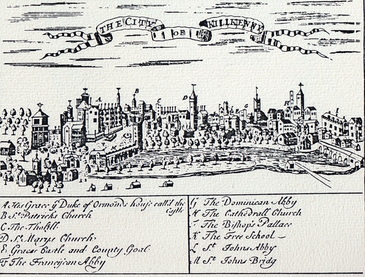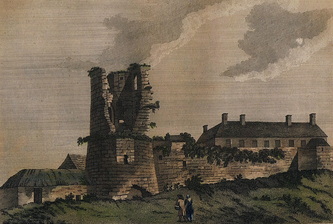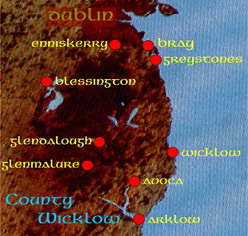- CLAN O'BYRNE HOME PAGE
- New Page
- NEW!! UNCOVER YOUR PAST ! !
- CLAN O'BYRNE EVENTS ARCHIVE
- Who do YOU think you are ? The Clan O'Byrne DNA Project
- FORUMs
- BYRNE HERALDRY
- Clan O'Byrne Gathering Rally Poll
- The Gathering Rally Quick Guide
- News , Updates and Archives
- Clan O'Byrne Background
- The Clans of Ireland
- Histories of the O'Byrnes
-
Sept families of the Leinster Byrnes
- Leinster Clans Alliance
-
Clan Rallies of the O'Byrnes
- St. Geri 2008
- Well known and not so well known Byrnes
- Ancestors sought and hoped for.
- Blogs for Byrnes
- Clan O'Byrne Video Vault
- Publications, Links and Sources
- Irish Order of Knighthood
- Google Wicklow
- Drives thro County Wicklow
- Membership registration form
- Clan Ó Byrne Members only
THE O'BYRNES and the Confederation of Kilkenny 1640-1650

The City of Kilkenny 1610
By inquisition taken 5th August 1638 at Wicklow and now in the Rolls office of Chancery Dublin the O'Bymes country was found to consist of the Baronies of
Newcastle, Arklow and Ballinacor, and the territory of Shillelagh and all which
adjoins the county of Wexford, and nearly half the county on the sea coast as
well as considerable parts of east Carlow. Its chief town Wicklow a sea port
assize borough market and post town partly in the parish of Rathnew barony of
Newcastle but mainly in that of Kilpoole barony of Arklow - its ancient name Wickinglow is derived from its situation at the southern extremity of a narrow creek shut out from the sea by peninsula call the Murrah.
It was one of the Danish ports before occupation by the Normans in 1170 and called by the Danes Wiggingelough - Lake of ships afterwards it formed part of the extensive possession granted by Strongbow to Maurice Fitzgerald who commenced the building of a castle for protection but which was discontinued on his death in 1176. His sons were dispossessed by William Fitzaldelm. In 1301 the town was burnt by the O'Byrnes but the castle was afterwards put in a state of defence by William Fitzwilliam. From its vicinity
to the O'Bymes and the O'Tooles it was a frequent object of contention and fell back into the hands of the O'Bymes in the early 1500's and it was surrendered back to HenryVill in 1534. In 1641 Luke O'Toole invested the castle, but had to came the siege on the approach of the English army but not before slaughtering the inhabitants of the town.
REBELLION 1641-1651
The rebellion was an alliance of old English and Gaelic Irish - Catholics and supporters of the King against the New English Puritans and Scottish parliamentarians
The chief agitator of the rebellion of 1641 was Rory O'Moore and his associates Hugh O'Byrne a fierce conspirator whose father had been oppressed and deprived of his lands by Parsons the Lord Justice, Turlough O'Neill, Philip O'Reilly, Hugh McMahon, Sir James Dillon and Brian Byrne.
The troops levied for the Spanish service were detained in Ireland by Huge O'Byrne and his fellow confederates and for their pay they proposed to seize all other rents of the kingdom and expected a reward from the Popes funds. The insurrection was intended to be favourable general ant the time was to be winter so that supplies would have great difficulty coming from England. October 23rd after a delay was to see commencement of hostilities.
O'Byrne and O'Moore were to surprise Dublin Castle they were to employ 200 men
from Ulster and Leinster - and to force two gates at the one time. Colonel Hugh
O'Byrne also represented Owen Roe O'Neill at negotiations.
THE O'BYRNES AND THE CATHOLIC CONFEDERATION OF KILKENNY
Catholic Confederation of Kilkenny 1642
By 1641 the political situation in England was set to boil over into civil war. Ireland was ruled by two lord justices Barlase and Parsons. Both were Puritans and their rule was very harsh. The oppressed Irish decided to rebel. The principal leaders of the old Irish were Felim O'Neill, Conor Maguire, Rory O'Neill and Brian and Hugh MacPhelim O'Byme. Brian MacPhelim was the O'Byrne chief since 1630. Father Luke Wadding sought help from the Pope and Richelieu.
The plan was to capture Dublin Castle. But this plan was given away by a traitor. The fighting first broke out in Ulster. The O'Neills under Sir Felim O'Neill killed 10,000 settlers. The rising swept the country. Hugh
MacPhelim O'Byrne was declared an outlaw in 1641.
Fiach O'Byme of Kilcloron was proclaimed a rebel on 8th February 1641. The Catholic Confederation of Kilkenny was founded in 1642. This was a parliament for Catholics. The established parliament was for Protestants. The men who met at Kilkenny were not united. The Anglo Irish Lords were fighting to
protect the Catholic religion. The Gaelic Lords were fighting to preserve their language, civilization and regain their lost Lands. In 1642 Owen Roe O'Neill and General Preston returned from the continent. Meanwhile the English Civil War had begun.
In Wicklow the Confederation forces held all the principal castles. The O'Byrne and O'Toole held the Black Castle in Wicklow. Sir Charles Coote later Earl Mountrath took the castle. He gathered the local Catholic
population and locked them in the Catholic Church. He then proceeded to burn the Church to the ground. The Franciscan Abbey was also destroyed.
Hugh MacPhelim and Brian O'Byrne were appointed Lieutenant General and Colonel in the Confederation army respectively. The Confederation army retook the Black Castle in 1646. Colonel Luke O'Toole of Castlekevin was the commanding officer of the castle. Arklow castle was occupied by the Confederation forces. They were driven out. But they reoccupied the castle on 5th of June 1647. On the 20th of September 1648 Lieutenant General Hugh O'Byrne was appointed governor of Wicklow. In 1649 Cromwell destroyed the Black Castle. The Confederation forces retreated into the mountains. Cromwell's troops burnt
Glenealy Church and massacred the local inhabitants at Madden's Bank. The Cromwellions moved into the mountains after the O'Byrnes and O'Tooles. Brian MacPhelim O'Byrne ambushed large amounts of Cromwell's cavalry in the mountain passes. Christopher O'Toole stole Cromwell's horse. The eternal destroyer attempted to ransom his horse but the O'Tooles refused.
Arklow fell to Cromwell on September 29th 1649. Eight weeks Arklow was under siege by Confederation forces under Brian MacPhelim O'Byme and his brother. This time Arklow was saved by the timely arrival of General Hewson, with 1,000 men.
In January 1650 the O'Byrne/O'Tooles laid siege to the Castle once more. The constable of the castle, Barrington was not intimidated and marched out of Arklow. He met the clans and fought a long and bitter battle. It was a very bloody battle and no quarter was given on either side. It resulted in one of the most hard fought victories the English ever won in Ireland. It was the final effort made by the ancestral Princes in Wicklow to recover their ancestral lands. Never again did they threaten or appear in force before Arklow.
The O'Bymes and the O'Tooles retreated into the hills.
A peace was signed on 12th May 1652. From their hills the O'Bymes refused to accept the peace and continued to resist. Along with the Kavanaghs and the O'Tooles they continued to resist. The Cromwellians were determined to starve them out of their mountain fortresses. The Cromwellians gathered an army
of 7,000. They destroyed the harvest of 1652. Without corn and cattle they reckoned resistance would crumble. This resulted in a mini famine in Wicklow Brian and Hugh were in constant danger of betrayal. Donogh McShane, McMurtha tried to capture the brothers.
The brothers O'Byrne were exempt from all pardon and a reward of £400 was placed on their heads. During 1652 Lieutenant General Hugh O'Byrne managed to reach a Catholic country. Brian O'Byrne hid on the island of Inisbofinn with Rory O'Moore. Rory O'Moore died there: Sir Felim O'Neill was executed. Colonel Luke O'Toole of Castlekevin was brutally executed by Cromwell's creative’s at the Castle.
Now wholesale eviction of the Catholic gentry of Wicklow commenced. Cromwell gave them the choice of "to to hell or to Connaught".
An officer of Hugh MacPhelim O'Byrne, Lieutenant Colonel James O'Byrne returned to his former lands in 1659. He was caught on 8th August 1659 and transported back to Galway. Hugh McPhelim O'Byrne's fate is unknown. Brian MacPhelim O'Byrne, the O'Byrne chief is buried in the Church of Ireland graveyard in
Rathdrum.
This was the part the Clan O'Byrne played during period of Catholic Confederation of Kilkenny. It was a part they paid a heavy price for. It shattered O'Byrne power as a military force. Never again would they be a significant threat to the English.
Dr Emmet O'Byrne, first published in An Leabhar Branach, Clan O’Byrne 1992
Newcastle, Arklow and Ballinacor, and the territory of Shillelagh and all which
adjoins the county of Wexford, and nearly half the county on the sea coast as
well as considerable parts of east Carlow. Its chief town Wicklow a sea port
assize borough market and post town partly in the parish of Rathnew barony of
Newcastle but mainly in that of Kilpoole barony of Arklow - its ancient name Wickinglow is derived from its situation at the southern extremity of a narrow creek shut out from the sea by peninsula call the Murrah.
It was one of the Danish ports before occupation by the Normans in 1170 and called by the Danes Wiggingelough - Lake of ships afterwards it formed part of the extensive possession granted by Strongbow to Maurice Fitzgerald who commenced the building of a castle for protection but which was discontinued on his death in 1176. His sons were dispossessed by William Fitzaldelm. In 1301 the town was burnt by the O'Byrnes but the castle was afterwards put in a state of defence by William Fitzwilliam. From its vicinity
to the O'Bymes and the O'Tooles it was a frequent object of contention and fell back into the hands of the O'Bymes in the early 1500's and it was surrendered back to HenryVill in 1534. In 1641 Luke O'Toole invested the castle, but had to came the siege on the approach of the English army but not before slaughtering the inhabitants of the town.
REBELLION 1641-1651
The rebellion was an alliance of old English and Gaelic Irish - Catholics and supporters of the King against the New English Puritans and Scottish parliamentarians
The chief agitator of the rebellion of 1641 was Rory O'Moore and his associates Hugh O'Byrne a fierce conspirator whose father had been oppressed and deprived of his lands by Parsons the Lord Justice, Turlough O'Neill, Philip O'Reilly, Hugh McMahon, Sir James Dillon and Brian Byrne.
The troops levied for the Spanish service were detained in Ireland by Huge O'Byrne and his fellow confederates and for their pay they proposed to seize all other rents of the kingdom and expected a reward from the Popes funds. The insurrection was intended to be favourable general ant the time was to be winter so that supplies would have great difficulty coming from England. October 23rd after a delay was to see commencement of hostilities.
O'Byrne and O'Moore were to surprise Dublin Castle they were to employ 200 men
from Ulster and Leinster - and to force two gates at the one time. Colonel Hugh
O'Byrne also represented Owen Roe O'Neill at negotiations.
THE O'BYRNES AND THE CATHOLIC CONFEDERATION OF KILKENNY
Catholic Confederation of Kilkenny 1642
By 1641 the political situation in England was set to boil over into civil war. Ireland was ruled by two lord justices Barlase and Parsons. Both were Puritans and their rule was very harsh. The oppressed Irish decided to rebel. The principal leaders of the old Irish were Felim O'Neill, Conor Maguire, Rory O'Neill and Brian and Hugh MacPhelim O'Byme. Brian MacPhelim was the O'Byrne chief since 1630. Father Luke Wadding sought help from the Pope and Richelieu.
The plan was to capture Dublin Castle. But this plan was given away by a traitor. The fighting first broke out in Ulster. The O'Neills under Sir Felim O'Neill killed 10,000 settlers. The rising swept the country. Hugh
MacPhelim O'Byrne was declared an outlaw in 1641.
Fiach O'Byme of Kilcloron was proclaimed a rebel on 8th February 1641. The Catholic Confederation of Kilkenny was founded in 1642. This was a parliament for Catholics. The established parliament was for Protestants. The men who met at Kilkenny were not united. The Anglo Irish Lords were fighting to
protect the Catholic religion. The Gaelic Lords were fighting to preserve their language, civilization and regain their lost Lands. In 1642 Owen Roe O'Neill and General Preston returned from the continent. Meanwhile the English Civil War had begun.
In Wicklow the Confederation forces held all the principal castles. The O'Byrne and O'Toole held the Black Castle in Wicklow. Sir Charles Coote later Earl Mountrath took the castle. He gathered the local Catholic
population and locked them in the Catholic Church. He then proceeded to burn the Church to the ground. The Franciscan Abbey was also destroyed.
Hugh MacPhelim and Brian O'Byrne were appointed Lieutenant General and Colonel in the Confederation army respectively. The Confederation army retook the Black Castle in 1646. Colonel Luke O'Toole of Castlekevin was the commanding officer of the castle. Arklow castle was occupied by the Confederation forces. They were driven out. But they reoccupied the castle on 5th of June 1647. On the 20th of September 1648 Lieutenant General Hugh O'Byrne was appointed governor of Wicklow. In 1649 Cromwell destroyed the Black Castle. The Confederation forces retreated into the mountains. Cromwell's troops burnt
Glenealy Church and massacred the local inhabitants at Madden's Bank. The Cromwellions moved into the mountains after the O'Byrnes and O'Tooles. Brian MacPhelim O'Byrne ambushed large amounts of Cromwell's cavalry in the mountain passes. Christopher O'Toole stole Cromwell's horse. The eternal destroyer attempted to ransom his horse but the O'Tooles refused.
Arklow fell to Cromwell on September 29th 1649. Eight weeks Arklow was under siege by Confederation forces under Brian MacPhelim O'Byme and his brother. This time Arklow was saved by the timely arrival of General Hewson, with 1,000 men.
In January 1650 the O'Byrne/O'Tooles laid siege to the Castle once more. The constable of the castle, Barrington was not intimidated and marched out of Arklow. He met the clans and fought a long and bitter battle. It was a very bloody battle and no quarter was given on either side. It resulted in one of the most hard fought victories the English ever won in Ireland. It was the final effort made by the ancestral Princes in Wicklow to recover their ancestral lands. Never again did they threaten or appear in force before Arklow.
The O'Bymes and the O'Tooles retreated into the hills.
A peace was signed on 12th May 1652. From their hills the O'Bymes refused to accept the peace and continued to resist. Along with the Kavanaghs and the O'Tooles they continued to resist. The Cromwellians were determined to starve them out of their mountain fortresses. The Cromwellians gathered an army
of 7,000. They destroyed the harvest of 1652. Without corn and cattle they reckoned resistance would crumble. This resulted in a mini famine in Wicklow Brian and Hugh were in constant danger of betrayal. Donogh McShane, McMurtha tried to capture the brothers.
The brothers O'Byrne were exempt from all pardon and a reward of £400 was placed on their heads. During 1652 Lieutenant General Hugh O'Byrne managed to reach a Catholic country. Brian O'Byrne hid on the island of Inisbofinn with Rory O'Moore. Rory O'Moore died there: Sir Felim O'Neill was executed. Colonel Luke O'Toole of Castlekevin was brutally executed by Cromwell's creative’s at the Castle.
Now wholesale eviction of the Catholic gentry of Wicklow commenced. Cromwell gave them the choice of "to to hell or to Connaught".
An officer of Hugh MacPhelim O'Byrne, Lieutenant Colonel James O'Byrne returned to his former lands in 1659. He was caught on 8th August 1659 and transported back to Galway. Hugh McPhelim O'Byrne's fate is unknown. Brian MacPhelim O'Byrne, the O'Byrne chief is buried in the Church of Ireland graveyard in
Rathdrum.
This was the part the Clan O'Byrne played during period of Catholic Confederation of Kilkenny. It was a part they paid a heavy price for. It shattered O'Byrne power as a military force. Never again would they be a significant threat to the English.
Dr Emmet O'Byrne, first published in An Leabhar Branach, Clan O’Byrne 1992
Design and Graphics by Val Byrne. Copyright © 2013 Val Byrne. All rights reserved.


